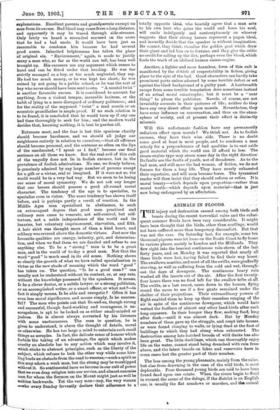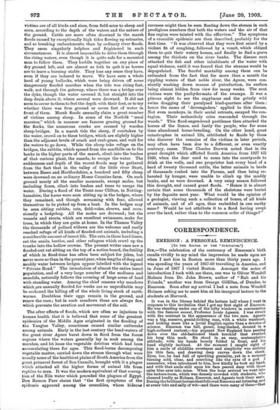ANIMALS IN FLOODS. T HE injury and destruction caused among both
birds and beasts during the recent torrential rains and the subse- quent summer floods have been very considerable. It might have been thought that the birds, other than nestlings, would not have suffered more than temporary discomfort. But that was not the case. On Saturday last, for example,- some teh thousand pigeons were let loose on the South Coast to fly bomb to various places, mainly in London and the Midlands. They flew right into the heaviest continuous rain-storm of the last forty years, and on Monday it was reported that nearly all these birds were lost, having failed to find their way hornd. The swallows, martins, and most of all the swifts, were gradually starving, as well as suffering from the cold and wet, throug11.- out the days of downpour. The continuous heavy rain washed all the insects out of the air. After the first twenty- four hours there was no food left for the swallow tribe at all. The swifts, as a last resort, came down to the houses, flying round the eaves to see if a few gnats remained under the shelter of their projections. Their extraordinary powers Of flight enabled them to keep up their ceaseless ranging of the air in spite of the continuous downpour, which would haie wetted the feathers of almost any other land-birds after such long exposure. In their hunger they flew, seeking food, long after dusk,—until it was almost dark. But by Monday numbers of them gave up the struggle, and crept into houses, or were found clinging to walls, or lying dead at the foot of buildings to which they had clung when exhausted. The destruction among late-hatched broods of wild ducks has also been great. The little ducklings, which can thoroughly enjoy life on the water, cannot stand being drenched with rain from above, and the latest broods on lakes and reservoirs have in some cases lost the greater part of their number.
The loss among the young pheasants, mainly from the rains, but also from drowning in the case of the wild birds, is most deplorable. Four thousand young birds are said to have been found dead upon one estate. When the rivers begin to flood in earnest the scene of the deluge, if the district is an English one, is usually the flat meadows or marshes, and the animal
victims are of all kinds and sizes, from field-mice to sheep and oxen, according to the depth of the waters and the nature of the ground. Cattle are more often drowned in the marsh floods caused by exceptionally high tides flowing up estuaries, and so breaking embankments, than by ordinary river floods. They seem singularly helpless and frightened in such circumstances. It is almost impossible to drive them through the rising waters, even though it is quite safe for a mounted man to follow them. They huddle together on any piece of dry ground left, and are almost as loth to quit it as horses are to leave a burning stable. They lose any sense they have, even if they are induced to move. We have seen a whole herd of young bullocks, which were being driven off some dangerously flooded marshes when the tide was rising fast, walk, not through the gateway, where there was a bridge over the dyke, though the water covered it, but straight into the deep drain above it, where several were drowned. It did not seem to occur to them to feel the depth with their foot, or to try whether there was firm ground or seven feet of water in front of them. Marsh floods annually claim a great number of victims among sheep. In some of the Norfolk "meal marshes," which in summer are famous grazing ground for the flocks, the numerous creeks are crossed by wooden sheep-bridges. In a marsh tide the sheep, if overtaken by the water, crowd on to these bridges, which are slightly higher than the adjacent levels of orach and crab-grass, and wait for the waters to go down. While the sheep take refuge on the bridges, the rabbits, which spread from the sandhills on to the banks in the higher parts of the marsh, climb into the bushes of that curious plant, the suaeda, to escape the water. The suddenness and depth of the recent floods may be gathered from the fact that in the valley of the little river Stort, between Essex and Hertfordshire, a hundred and fifty sheep were drowned on an ordinary Home Counties farm. On such ground nearly all the smaller mammals, except moles, but including foxes, climb into bushes and trees to escape the water. During a flood of the Trent near Clifton, in Notting- hamshire, the hares were seen sitting up in the hedges, where they remained, and though screaming with fear, allowed themselves to be picked up from a boat. In the hedges may be seen sitting rabbits, rats, field-voles, shrews, and occa- sionally a hedgehog. All the moles are drowned; but the weasels and stoats, which are excellent swimmers, make for trees, in which they are quite at home. In the Thames Valley the thousands of pollard willows are the welcome and easily reached refuge of all kinds of flooded-out animals, including a considerable amount of insect life. The rats, in these hard times, eat the snails, beetles, and other refugees which crawl up the trunks into the hollow crowns. The present writer once saw a flooded-out rat sitting on the top of a notice-board, the futility of which in flood-time has often been subject for jokes, but never more so than in the present year, when lengths of deep and muddy water between hedges appear labelled with the legend "Private Road." The immolation of almost the entire insect population, and of a very large number of the mollusca and annelids, naturally follows the covering of large areas of land with standing water. Among the chief reasons why meadows which are annually flooded for weeks are so unprofitable may be reckoned the killing off of the whole living stock of earth- worms. Doubtless their eggs remain in the ground, and renew the race ; but in such meadows these are always few, which prevents the aeration and movement of the soil.
The after effects of floods, which are often so injurious to human health that it is believed that some of the greatest epidemics of the Middle Ages originated in the flooding of the Yang,tse Valley, sometimes caused similar outbreaks among animals. Early in the last century the head-waters of the great river Apure burst down in flood from the forest regions where the waters generally lay in soak among the marshes, and let loose the vegetable detritus which had been accumulating there for ages. This flood-borne decomposing vegetable matter, carried down the stream through what were usually some of the healthiest plains of South America from the great primeval forest of San Carmilo, brought with it a plague which attacked all the higher forms of animal life from reptiles to man. It was the modern equivalent of that corrup- tion of the Nile water which preceded the plagues of Egypt. Don Ramon Paez states that "the first symptoms of the epidemic appeared among the crocodiles, whose hideous carcases might then be seen floating down the stream in such prodigious numbers that both the waters and the air of that fine region were tainted with the effluvium." The symptoms of a crocodile epidemic are then described, probably for the first time. "It was observed that they were first seized by a violent fit of coughing, followed by a vomit, which obliged them to quit their watery homes, and finally to find a grave among the thickets on the river banks. The disease next attacked the fish and other inhabitants of the water with equal violence, until it was feared that the streams would be depopulated. The fearful mortality among them can be estimated from the fact that for more , than a month the rippling waters of that noble river, the Apure, were con- stantly washing down masses of putrefaction, its surface being almost hidden from view for many weeks. The next victims were the pachydermata of the swamps. It was a piteous sight to see the capybaras and the grizzly wild swine dragging their paralysed hind-quarters after them : hence the name of derrengadera ' applied to this disease. Not even monkeys, in their aerial retreats, escaped the con- tagion. Their melancholy cries resounded through the woods." This flood-engendered pestilence then attacked the horses of the llanos, and lastly the people, who for some time abandoned horse-breeding. On the other hand, great catastrophes in animal life, attributed to floods by those who discover the remains of the victims in later periods, may often have been due to a different, or even exactly contrary, cause. Thus Charles Darwin noted that in the great drought which afflicted South America from 1827 till 1830, when the deer used to come into the courtyards to drink at the wells, and one proprietor lost every head of a herd of twenty thousand cattle, the latter animals in herds of thousands rushed into the Parana, and then being ex- hausted by hunger, were unable to climb up the muddy banks, and so were drowned. A very rainy season followed this drought, and caused great floods. "Hence it is almost certain that some thousands of the skeletons were buried by the deposits next year. What would be the opinion of a geologist, viewing such a collection of bones, of all kinds of animals, and of all ages, thus embedded in one earthy mass ? Would he not attribute it to a flood having swept over the land, rather than to the common order of things ?"











































 Previous page
Previous page